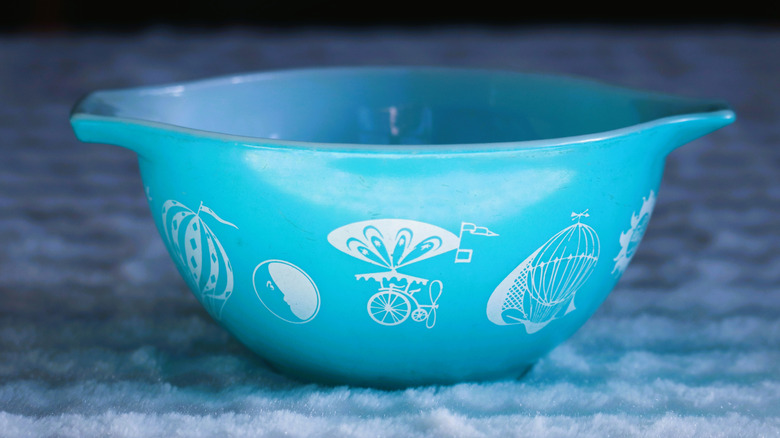What To Look For When Authenticating Your Vintage Pyrex Pieces
Cookware has significantly evolved from the clay, stone, and copper pots and pans that ancient humans used. Through that evolution, tempered glass — such as those from popular brands like Pyrex and Anchor Hocking — has become the norm. The Pyrex line of baking dishes remains a favorite today, but it's the beautiful patterns on its bowls and casserole dishes that catch the eyes of both young and old generations. Whether your grandmother gave you vintage Pyrex kitchenware or you're looking for some to add to your collection, looking for the backstamp is the best way to authenticate it.
The Pyrex brand of heat-resistant glass ovenware was launched by Corning Glass Works (now Corning Incorporated) in 1915. According to "Pyrex by Corning: A Collector's Guide" by Marcia Buan Steinhauer and Susan Tobier Rogove, between that launch and 1965 alone, the glassmaker used more than 20 different backstamps (otherwise known as trademarks). Included in the backstamps are various combinations of letters — such as a CG monogram of Corning Glassworks, T.M. REG., and U.S. PAT. OFF. Also, the numbers on the bottom of your Pyrex refer to the model of your specific kitchenware and its pattern. The primary thing to look for that all of these and other vintage backstamps have in common, though, is the brand logo in all caps: PYREX.
When Corning Incorporated sold its housewares division Corning Consumer Products in 1998, new owner Borden — which rebranded as World Kitchen in 2000 but merged with Instant Pot to create Instant Brands in 2021 — adopted a lowercase logo for its backstamps: pyrex. Products made with this trademark are generally considered "new" versus "old."
What makes vintage Pyrex different from the newer products?
Aside from the uppercase and lowercase logos, there are a couple of differences between vintage and new Pyrex kitchenware: the material and the designs. The first main difference is that the vintage cookware was initially made with borosilicate glass. In the early 20th century, this material was less expensive compared to others, as well as more heat resistant and able to be tempered to hold up under an array of temperatures.
Corning used borosilicate glass for decades, and these Pyrex pieces are very sought-after and rare because the glass is considered by many to be inferior to thermally tempered soda-lime glass. The company started adopting this material in the 1940s or 1950s because it was even cheaper to produce, but the Pyrex cookware made during this time is still considered vintage. And, since Corning sold its housewares division to what is now Instant Brands, all items made in the United States feature a soda-lime formulation. Borosilicate is still used to make Pyrex in Europe, though.
Meanwhile, Corning was already using soda-lime glass to make the painted and decorated opal glass that has made the brand so iconic. These distinct designs were produced from 1945 to 1986, and there were more than 150 of them. However, some people try to pass off brandless kitchenware as Pyrex by putting decals on them. Because of that, the backstamp is still the best indicator of its authenticity. If you're having trouble making out the backstamp to authenticate its vintage status because of grime and stains, you can clean Pyrex dishes and get rid of tough stains by soaking them in a combination of baking soda, dish soap, and hot water.

